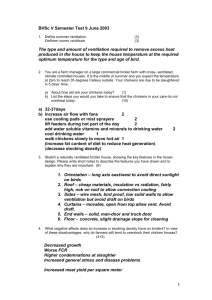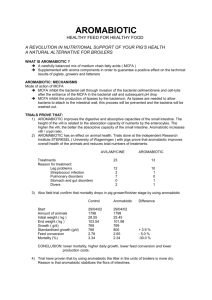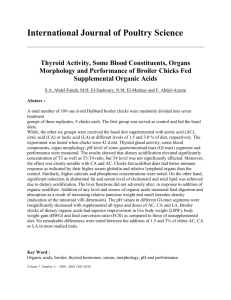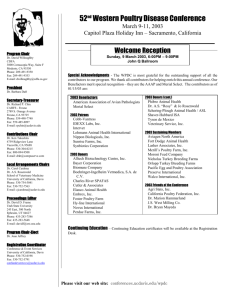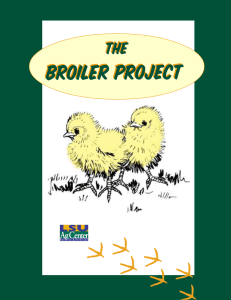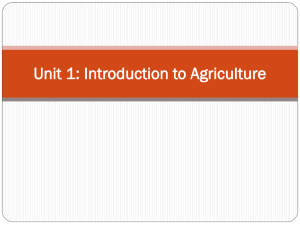Broiler Production Noel L. Bennion 4.4%\v. \. '11
advertisement
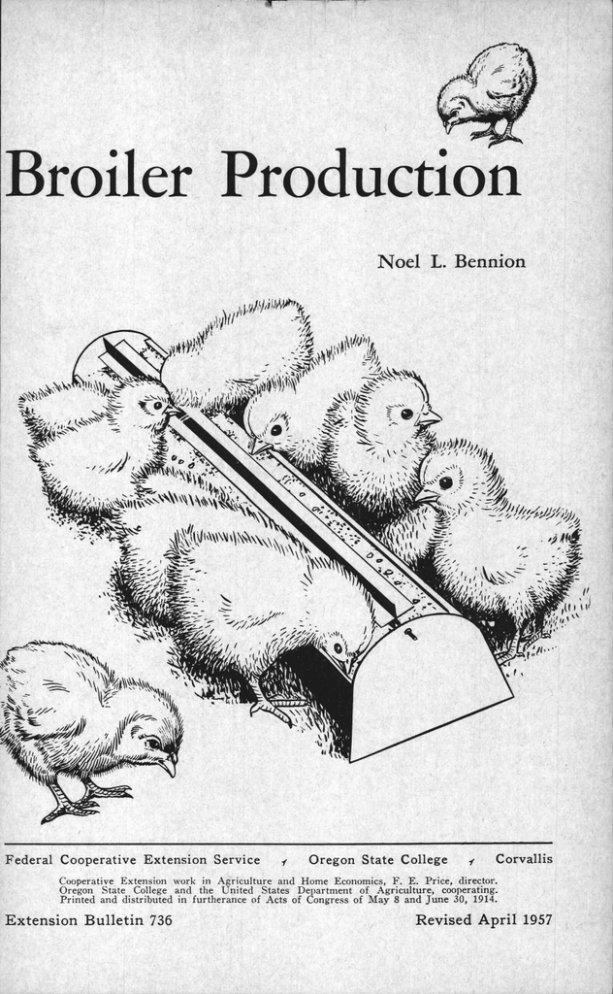
Broiler Production Noel L. Bennion ,%0?1100)1` = - Sol;VPii4 v.444) '11- 11''Y,1)1!/110. st*\ a., t 41) 5 4.4%\v. \. 01, IA. _ k \\\ \\\ \\1 \\4.' N\k\\ Federal Cooperative Extension Service 1 Oregon State College Corvallis Cooperative. Extension work in Agriculture and Home Economics, F. E. Price, director. Oregon State College and the United States Department of Agriculture, cooperating. Printed and distributed in furtherance of Acts of Congress of May 8 and June 30, 1914. Extension Bulletin 736 Revised April 1957 1. A battery used for starting broilers for first 3 weeks. Figure 4301 It - Lt. mot/ Figure 2. An intermediate battery J I e used for broilers from 3 to 6 weeks of age. r I Figure 3. A finishing battery use for broilers from 6 weeks until marketed. Broiler Production NOEL L. BENNION Poultry Specialist 34 million broilers were produced in the United States in 1934, the first year that records were kept on APROXIMATELY broiler production. In 1956 there were over 1,300,000,000. This has been one of the outstanding developments in the history of the poultry industry. Fifteen years ago it required about 12 weeks and 12 pounds of feed to produce a 3-pound broiler. Today this is being done in 9 weeks on less than 8 pounds of feed. In 1956 the per capita consumption of broilers in the United States was about 16.5 pounds eviscerated weight. This was over 30 per cent of the chicken consumed in the United States. This progress has been brought about through improved methods of feeding, breeding, management, processing and marketing. The broiler industry in Oregon has been gaining rapidly also. In 1934 Oregon produced nearly 120,000 broilers. In 1956 more than 8,382,000 were produced. Oregon is still consuming over 25 per cent more broilers than we are producing according to the national per capita consumption. Inasmuch as a new crop of broilers can be raised in 10 weeks, the price cycle may be of short duration. There can be a surplus with low prices, and 3 months later a shortage and high prices. Even during periods of comparatively high prices the competition is keen and the margin of profit per bird is small. This means that a large volume must be handled for a producer to make a living raising broilers. The most successful growers follow the price cycles. They also keep a close watch on the weekly broiler placement reports to try to avoid depressed markets. Three Systems of Broiler Production In general there are three types of broiler-growing operations in Oregon : (1) The continuous operation using batteries for chicks (see figures 1, 2, 3), (2) The egg-production farm, raising broilers as a sideline, and (3) All inall out commercial broiler growing. 3 r 4 EXTENSION BULLETIN 736 Continuous Operation The continuous operation may be large or small. Most of them start from 100 to 1,000 day-old chicks or more per week. Under such a system, many producers do their own processing once or twice a week and sell direct to consumers, retailers, hotels, restaurants, and night clubs. Most of these birds are raised in batteries or wire pens, or a combination of the two. Figures 1, 2, and 3 show a battery setup for raising broilers. For this type of program, usually three different sets of batteries are required ; starting, intermediate, and finishing. A separate room is desirable for each unit. For example, a thousand chicks may be started each week, 500 to a battery as shown in figure 1. About 100 chicks are placed in each section of this battery where they are held for 3 weeks. Then they are moved to the growing room and placed in intermediate batteries as shown in figure 2. At this time they are reduced to 50 chicks per section. This intermediate battery provides more head room and is not equipped with heating units. At 6 weeks of age they are moved to the finishing rooms-25 birds to each unit, as shown in figure 3. They remain here until 9 to 10 weeks of age, when they are slaughtered. Theoretically, the growing or intermediate room should be about 100 per cent larger than the starting room, and the finishing room about twice as large as the intermediate room. This will depend on the size of the starting room and the number of birds started each week. Some growers use just starting and intermediate batteries in one or two rooms. The recommendations of the manufacturer should be followed as to floor, watering, and feeder space per bird at various ages. It may be neces- sary to adjust the feed and water troughs if intermediate batteries are also used for finishing, to avoid breast blisters. The temperature of the starting and intermediate rooms should range from 60 to 70 degrees. The temperature in the finishing room should range from 50 to 60 degrees. For best results the relative humidity in all three rooms should be from 70 to 75 per cent. Every battery plant should have a hygrometer for checking the relative humidity. Each room should be equipped with forced draft ventilation, supplemental heat if necessary, and constructed so that it can be cleaned and disinfected easily. Figures 4, 5, and 6 show some laborsaving equipment used for feeding and cleaning with a battery setup. Figure 4 shows steam equipment being used to clean and disinfect batteries between broods. A portable rack used for removing droppings is shown in figure 5. A bulk feed cart on wheels is being filled as shown in figure 6. Figure 7 shows a battery room used for BROILER PRODUCTION starting broilers for the first 3 weeks. They are then moved to wire pens as shown in figure 8. These pens are 16 by 20 feet. Five hundred birds are placed in each one. The room is heated by forced draft hot air. Two advantages of raising broilers in batteries are : a grower can produce a continuous supply for specialized markets, and he can obtain a premium price by selling direct to a high class trade. The main disadvantages are : respiratory diseases, breast blisters, and the high investment in equipment. A grower should obtain nothing but day-old chicks from nearby hatcheries to reduce the disease hazards. Started chicks or other poultry of any kind are always a source of danger. Breast blisters will be more of a problem with broilers if they are held on wire after they reach 3 pounds. Before going into this type of program the available markets should be analyzed. The individual's ability to process, package, and sell should be a major consideration. Figure 11 shows a home processing plant. The exterior is alumi- num, the interior is sealed and equipped so that it can qualify for a state license. Figure 12 shows a killing wheel, scalder, and picker that help to save processing labor. Figure 13 shows the interior of a room where the broilers are cut up and packaged ready for the pan. Broiler Production as a Sideline The second type of operation is egg production, with one or two groups of broilers raised as a sideline during the off season when the brooder house is not being used to raise replacement stock. Most of these birds are raised on the floor and brooded in a manner similar to that of replacement stock. They are usually sold to processors and all are marketed at the same time. In some cases the pullets, or at least part of them, are carried over to keep the laying pens filled to capacity. Figure 9 shows a large brooder house, 50 by 200 feet, that is used for raising flock replacements and broilers. This house will handle 10,000 pullets up to 9 or 10 weeks of age, or the same number of broilers. It is aluminum construction with a cement foundation and a blacktop or asphalt floor. It has the same amount of window space on both sides with the large gable ventilator and a driveway down the center. Figure 10 shows an interior view of this house with an automatic feeder and electric brooder. Figures 14, 15, and 16 show another typical operation of this kind. The house shown in figure 14 is 36 feet wide and 175 feet ; .1.14A wooer Figure 4. Battery equipment beins cleaned with steam pressure. ..K..4iww:**wwow, 3 . Figure 5. A portable rack used fol removing droppings from batter. lea. Figure 6. A bulk feed cart on wheels used for feeding broilers. 6 BROILER PRODUCTION 7 long. This house is designed to handle 5,000 pullets for flock replace- ments or 5,000 broilers up to market age, providing 1 square foot of floor space per bird. It is constructed out of cement blocks with an aluminum roof with a drop ceiling, forced draft ventilation, and a large feed room 15 feet by 36 feet at one end. As shown in figure 15, it has a 4-foot alleyway down the center, equipped with a track and two carriers. One is used for feeding and the larger one for cleaning out. This house is divided into pens 30 by 16 feet, which will handle 500 broilers up to market age. Each pen is equipped with a gas brooder, running water, and roosts as shown in figure 16. The gas brooder is attached to the ceiling by a pulley, making it convenient to raise it to observe the chicks and to clean the pens. When the birds are old enough to get along without heat, the brooder is pulled up out of the way. The roosts are hinged to the side wall, making them easy to raise. They are not used for broilers. Some growers use box feeders for broilers. Figure 17 shows how chick boxes can be cut down to use as feeders while the chicks are small. A large box feeder is shown in figure 18. Laying Houses for Raising Broilers Some growers in Oregon raise broilers in laying houses. There are some advantages in having a house that can be used for both. This is true regardless of the size of operation. One of our Extension poultry projects for many years has been the proper adjustment of the size of the laying flock. Poultry producers have been encouraged to keep a family flock of 25 layers or less, a sideline flock of 500 or more, or a commercial flock of 4,000 or more. The houses shown in figures 19, 20, and 21 are designed to accommodate these three different units. Figure 19 shows a house (8 by 12 feet) equipped with a wire porch. This house will handle 25 to 35 layers or 100 to 125 broilers. A house of this size makes an ideal setup for small 4-H Club or Future Farmer projects for layers or broilers. The house in figure 20 is 30 feet wide and 110 feet long. It has a driveway down the center with a 10- by 30-foot feed room in the center. Each pen is 30 by 50 feet. It has the same amount of window space on both sides. It is of brick tile construction with a drop ceiling. This house will handle 1,000 layers or 3,000 broilers. The two-story house in figure 21 is 30 by 110 feet with a 10by 30-foot feed room in the center on each floor. It is equipped with track and carriers on each floor. The large carriers are used for 8 EXTENSION BULLETIN 736 Figure 7. A battery room used for starting broilers for the first 3 weeks before they are moved to wire pens or to the floor. cleaning and the small ones for feeding. This house has 4 pens, 2 on each floor. The pens are 30 by 50 feet with the same amount of window space on both sides. This house will accommodate 2,000 layers or 6,000 broilers. All InAll Out Program The third system commonly used for growing broilers is the all all out program. Most of the large commercial broiler growers use this system. Under this procedure the brooder house or houses are filled to capacity with day-old chicks. They are generally sold to processors all at one time when they reach an average weight of about 3 pounds. This usually takes about 10 weeks. This same proin gram is repeated three or four times per year. Some growers buy sexed chicks and raise the males and females in separate groups. By following this procedure they can be sold at different weights and ages. There is some evidence that it is more profitable to sell the pullets before the roosters. The males continue to make economical gains over a longer period. BROILER PRODUCTION 9 There are several different types of brooding used under this all in all out program. Most broilers are brooded on cement, board, or dirt floors in large pens. There are some wire and slat floor installations. Deep litter is used extensively. Many growers also use automatic feeders and bulk feed to save labor. Figures 22 and 23 show a large brooder house designed to handle 10,000 broilers on an all in all out program. It is 40 feet wide and 250 feet long without partitions. This house has a cement foundation with a dirt floor. It has the same amount of window space on both sides with the gable ventilator. This is an inexpensive house inasmuch as it is constructed of rough lumber. It has slide doors on both ends as shown in figure 23. This provides a driveway down the center for cleaning and feeding. This type of house could be used for laying hens, cattle, sheep, machine shed or other types of storage. Figure 24 shows a tractor equipped with a loader and scraper that saves time and labor in cleaning this type of house. It also shows two other houses that are duplicates of the one described. There are three houses side by side on this broiler plant. Each one will handle 10,000 broilers, making a total capacity of 30,000. Figure 25 shows the interior of one of these houses. There are 10 gas brooders on each side. The watering troughs consist of two - Figure 8. A wire pen used for raising broilers from 3 weeks of age until they are slaughtered. 10 EXTENSION BULLETIN 736 r r =Noir Figure 9. An aluminum brooder house 50 by 200 feet used for raising flock replacements and broilers. angle irons that run the full length of the building. They are attached to the uprights on both sides. The trough for the automatic feeder also extends the length of the building. Figure 26 shows how each brooder is equipped with a hover enclosure for the first week during the brooding period. Five hundred chicks are started under each brooder. After the first week the enclosure is removed. This means 10,000 chicks have access to one large room. Figure 27 shows how the brooders can be raised for feeding, watering, cleaning, and checking the chicks. They are gradually raised as the birds become old enough to get along with less heat. It takes skill and proper equipment to raise 10,000 broilers in one group. The temperature, feed, water, litter, and ventilation must be right. Figure 28 shows 10,000 broilers being raised on a slat floor with gas brooders. Five hundred chicks are started under each hover. This house, 30 feet wide and 300 feet long, has the same amount of window space on both sides. This is important to obtain proper ventilation. Some growers prefer a narrow brooder house for raising broilers as shown in figure 29. This house is 20 by 160 feet with a cement BROILER PRODUCTION 11 foundation and floor. It has a 10- by 20-foot feed room in one end. It has twice as much window space on the front side as shown in the picture. Narrow houses are used more extensively in hot climates because they are easier to ventilate. Brooders There are several different types of brooders and brooding systems being used successfully for raising broilers. Some of the most common are : gas, electric, coal, oil, infrared heat lamps, hot water, and forced draft hot air. Radiant heat has been used to some extent. The initial installation is high and it is difficult to regulate the temperature when the nights are cool and the days are warm. As previously mentioned, battery brooders are used by some growers for raising broilers. They are also used from 2 to 4 weeks for starting broilers before they are transferred to wire or slat pens or to the floor. In determining the type of brooding equipment to use, the original cost, the cost of operating, convenience of operating, available fuel, and type of brooder operation should all be taken into consideration. Figure 10. An interior view of the aluminum brooder house showing an automatic feeder and electric brooder. ' Ii Figure 11. A home processing plant. Figure 12. Killing wheel, scalder, and picker in a home processing plant. Figure 13. An interior view of a home Processing plant where the birds are cut up and packaged 12 ready for the pan. Figure 14. A brooder house on a commercial egg farm that is used for raising replacement stock and broilers. Figure 15. An interior view of the above brooder house showing a 4-foot alleyway down the center equipped with track and carriers. A pen in the above brooder house equipped with a gas brooder, running water, and Figure 16. roosts. 13 EXTENSION BULLETIN 736 14 Lifter The most common types of litter used in Oregon are : shavings, sawdust, peat moss, cedar-tow, and cut straw. Regardless of the kind of litter used, it should be dry when placed in the brooder house. Deep litter is used extensively in raising broilers. Some growers use the same litter for 2 or 3 or more groups of birds. This system may be all right if trouble is not encountered from diseases and parasites. Many growers prefer to clean out all old litter after each brood and start with fresh litter. Regardless of the litter used it is desirable to keep it as dry and free from packing or caking as possible. Hydrated lime thoroughly mixed with the top portion of the litter at the rate of about 1 pound to 6 square feet will help to keep it in better condition. Some growers follow the practice of adding a light application of new litter at intervals throughout the brooding period. With this program about 3 inches of litter is placed on the floor to begin with and about 2 inches of new litter is added two or three times during the 10-week period. Figure 17. Chick boxes cut down to use as feeders while the chicks are small. BROILER PRODUCTION 15 -.row 'glib -I Figure 18. A large open box feeder used by some growers. Feeding There are several different systems for feeding broilers, such as all mash, mash and grains, straight pellets, pellets and grain, and mash and pellets. Crumbles are also used, especially for starting dayold chicks. The most common feed plan is to feed an all mash high-energy ration from day-old until the birds are marketed. Practically all feed companies manufacture a high-energy broiler ration. A high-energy ration is one that is low in fiber and high in carbohydrates. It must be well balanced, containing an adequate supply of protein, carbo-, hydrates, vitamins, minerals, and other growth factors. Practically all broiler rations at the present time contain one of the antibiotics that stimulate growth and help reduce mortality. Some rations also carry a low level of one of the sulfa drugs, to control coccidiosis. Most growers supply hard insoluble grit either in separate hoppers or by sprinkling it on top of mash in regular hoppers. In feeding broilers, growers should buy their feed from a reliable company and follow their recommendations in feeding. If you decide to mix your own ration, a formula can be obtained from Oregon State College. Figure 19. An 8- by 12-foot house equipped with a wire porch. It will handle 25 layers or 100 broilers. "Nt Figure 20. A laying house designed to handle 1,000 layers or 3,000 broilers. doi - '11 T1111 _InClIr111 4111111111.11 r t 01! Figure 27. A two-story laying house that can also be used for raising broilers. It will accommodate 2,000 layers or 6,000 broilers. 16 17 BROILER PRODUCTION Table 1 will serve as a guide for growth, feed conversion, and cumulative feed consumption by 2-week periods for chicken broilers. This information is based on 2,000 chicks of 8 different kinds. The average mortality to 10 weeks of age was 2.03 per cent, which is comparatively low. TABLE 1GROWTH, FEED CONVERSION, AND CUMULATIVE FEED CONSUMPTION OF CHICKEN BROILERS (Based on 2,000 chicks of 8 different kinds) Feed per Average weights Age 0 Weeks 2 Weeks 4 Weeks 6 Weeks 8 Weeks 10 Weeks Both sexes Cockerels Pullets pound gain, cumulative (both sexes) Pounds Pounds Pounds Pounds .08 .31 .76 1.40 2.23 3.12 .08 .08 .30 .73 .32 .79 1.48 2.39 3.42 1.33 2.08 2.82 Feed consumed per chick, cumulative (both sexes) Pounds 0 1.50 1.99 2.31 2.53 2.79 0 .46 1.5 3.2 5.6 8.6 From O.S.C. Agricultural Experiment Station Circular of Information 528. Cannibalism is sometimes associated with feeding. It will occur under certain conditions regardless of the type of ration fed. The. most important management items in controlling cannibalism are sufficient floor, feeder, and watering space, adequate ventilation, proper temperature and light. High temperature and bright light will often start cannibalism. To darken the brooder house or battery room will help to control it. If it cannot be controlled through management it may be necessary to debeak the birds. Breeds The most popular breeds for broiler production are New Hampshires, White Plymouth Rocks, Barred Plymouth Rocks, and crossbreeds. The crossbreeds have included several different crosses such as : Barred Rock males on New Hampshire females, Cornish males on New Hampshire females, White Rock males that carry the silver factor on New Hampshire females, and Delaware males on New Hampshire females. In the past, the New Hampshire has been the most popular breed. During recent years, however, there has been an increased demand for white-feathered broilers or broilers with the Columbian pattern, which is white with black hackle, wing, and tail feathers. Males carrying dominant white or males carrying silver have been Figure 22. Shows a broiler house constructed of rough lumber with a dirt floor. It will handle 10,000 broilers. mom tom ono Imo MM. Figure 23. This brooder house has a driveway down the center with sliding doors at both ends. Figure 24. A tractor equipped with a loader and scraper for cleaning out brooder houses with a driveway. 18 equipped illirlf/In 6., Figure 25. The interior view of a large brooder house showing arrangements of gas brooders, automatic feeders, and angle-iron watering troughs. I fill IL/1111 4 ""4-. - Figure 26. A hover enclosure is placed around each brooder for the first week until the chicks learn how to properly bed down. Figure 27. The brooder is attached to the ceiling by a pulley so it can be raised for feeding, watering, cleaning, and checking on the chicks. 19 1ou'. 20 EXTENSION BULLETIN 736 - Figure 28. 10,000 broilers being raised on a slat floor with gas brooders. used extensively to cross on dark-feathered breeds to produce broilers with white feathers. The main reason for white-feathered birds is to avoid dark pin feathers. Just how far this trend will go remains to be seen. The New Hampshire breeders have attempted to overcome this objection to dark pin feathers by developing strains that are almost buff with light under color. Over the long pull it will be the breed or strain that can consistently produce the most economical gains that will be the most popular. In selecting broiler chicks, producers should bear in mind that the strain within a breed or the strains used to produce a cross is more important than the breed. Management Following are some general recommendations for raising broilers and replacement stock approved by the Nutrition Council of the American Feed Manufacturers Association. Oregon State College is in agreement with these recommendations. Each chick should be allowed a minimum of 7 square inches of brooder space under the hover. For electric brooder, up to 10 square inches per chick may be needed. BROILER PRODUCTION 21 Where chicks are brooded under individual brooder stoves or units, allow a maximum of 350 replacement chicks per brooder unit ; SOO broiler chicks per unit. For chicks reared in confinement, allow a minimum of square foot of brooder room floor space per bird through 6 weeks, and a minimum of 1 square foot per bird from 7 through 12 weeks. If roosts are to be used later for hens, provide them for the replacement chicks at 4 weeks of age. Allow 4 inches roosting space per chick. If roosts are not to be used for hens, do not use them for replacement chicks. Do not use roosts for broilers. Allow chicks the following feeder space : day-old through 2 weeks-100 linear inches per 100 chicks; 3 weeks through 6 weeks175 linear inches per 100 chicks ; 7 weeks through 12 weeks-300 linear inches per 100 chicks. Additional space should be provided in warm weather. (For example, a 4-foot hopper open to birds from both sides provides 96 linear inches of feeding space.) Provide 100 chicks the following drinking space : day-old through 2 weeks 20 linear inches, or two 1-gallon fountains ; 3 weeks through 12 weeks-40 linear inches, or two 3-gallon fountains. Additional space should be provided in warm weather. (For example, Figure 29. A narrow brooder house is preferred by some broiler growers, especially in warm climates, because it is easier to ventilate. Figure 30. Popular breeds for broilers include New Hampshires, upper right and White Plymouth Rocks, upper left. The crossbreeds are from Cornish males on New Hampshire females, lower left and Delaware males on New Hampshire females, lower right. The Columbian feather pattern that is produced by the latter cross can be produced by crossing males that carry the silver gene on New Hampshire or Rhode Island Red females. a 4-foot water trough open to birds from both sides provides 96 linear inches of drinking space.) In cold weather, use a solid chick guard around the hover to keep chicks from straying and to prevent floor drafts. In warm weather, a wire guard may be used. b' Place a guard 2 or 3 feet from edge of hover. Gradually expand it and remove at end of 1 week. Provide at least 2 inches of suitable litter at the start. Cane pulp, shavings, sawdust, crushed corn cobs, chopped straw, peanut hulls, peat moss, sand, and others may be used when free from injurious materials and reasonably free from dust. If litter is used for more than one brood of chicks, litter immediately under the brooder area should be entirely replaced for each brood. Remove all caked and damp material, resurface with 4.2 to 1 inch of fresh litter. Stir and add fresh litter as needed. Use all-night lights equivalent to 15 watts per 200 square feet of floor space. This helps to prevent pileups. BROILER PRODUCTION 23 Summary During the past 20 years the broiler industry in the United States and also in Oregon has had a rapid expansion. It looks as if production will level off, with possibly some gradual expansion in line with the increase in human population. In the per capita consumption of broilers in the United 1956 it was about 16.5 pounds eviscerated weight. This was over 50 per cent of the chicken consumed in the United States. This progress has been brought about through improved methods of feeding, breeding, management, processing, and marketing. 1934 States was less than 1 pound. In Inasmuch as a new crop of broilers can be raised in 10 weeks the price cycle is of short duration. There can be a surplus with low prices and 3 months later a shortage and high prices. Even during periods of comparatively high prices the competition is keen and the margin of profit per bird is small. Growers can avoid depressed markets to a certain extent by watching the weekly broiler placements and price cycles. In general there are three types of broiler growing in Oregon: (1) The continuous operation using batteries of chicks, (2) The egg- production farm, raising broilers as a sideline, and all out commercial broiler growing. (3) All in Before a person starts raising broilers the various systems of production, the available markets, cost of production, the individual's ability to manage, process, and market birds should be analyzed. Some growers are good at processing and marketing, while others will make more money by raising additional broilers and having the processor handle his birds. 0. There are many different types of houses, brooders, litter, laborsaving devices, systems of feeding, management, including several breeds, strains, and crosses used in producing broilers. Growers should adopt and follow a well planned program that has proved successful. For example, it is the breed or strain, the feed and management program that will consistently produce economical gains that should be adopted. Oregon State College Agricultural Experiment Station Circulars of Information 513 and 528 contain additional information on cost of producing broilers and growth and feed consumption, respectively.

